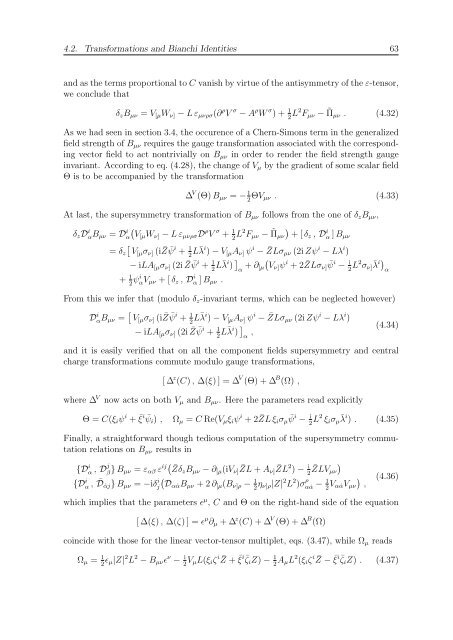N=2 Supersymmetric Gauge Theories with Nonpolynomial Interactions
N=2 Supersymmetric Gauge Theories with Nonpolynomial Interactions
N=2 Supersymmetric Gauge Theories with Nonpolynomial Interactions
You also want an ePaper? Increase the reach of your titles
YUMPU automatically turns print PDFs into web optimized ePapers that Google loves.
4.2. Transformations and Bianchi Identities 63<br />
and as the terms proportional to C vanish by virtue of the antisymmetry of the ε-tensor,<br />
we conclude that<br />
δzBµν = V[µWν] − L εµνρσ(∂ ρ V σ − A ρ W σ ) + 1<br />
2 L2 Fµν − ˜ Πµν . (4.32)<br />
As we had seen in section 3.4, the occurence of a Chern-Simons term in the generalized<br />
field strength of Bµν requires the gauge transformation associated <strong>with</strong> the corresponding<br />
vector field to act nontrivially on Bµν in order to render the field strength gauge<br />
invariant. According to eq. (4.28), the change of Vµ by the gradient of some scalar field<br />
Θ is to be accompanied by the transformation<br />
∆ V (Θ) Bµν = − 1<br />
2 ΘVµν . (4.33)<br />
At last, the supersymmetry transformation of Bµν follows from the one of δzBµν,<br />
δzD i αBµν = D i <br />
α V[µWν] − L εµνρσD ρ V σ + 1<br />
2L2Fµν − ˜ <br />
Πµν + [ δz , D i α ] Bµν<br />
<br />
= δz V[µσν] (i ¯ Z ¯ ψ i + 1<br />
2L¯ λ i ) − V[µAν] ψ i − ¯ ZLσµν (2i Zψ i − Lλ i )<br />
− iLA[µσν] (2i ¯ Z ¯ ψ i + 1<br />
2L¯ λ i ) <br />
+ ∂[µ Vν]ψ<br />
α i + 2 ¯ ZLσν] ¯ ψ i − i<br />
2L2σν] ¯ λ i<br />
α<br />
+ 1<br />
2ψi αVµν + [ δz , D i α ] Bµν .<br />
From this we infer that (modulo δz-invariant terms, which can be neglected however)<br />
D i αBµν = V[µσν] (i ¯ Z ¯ ψ i + 1<br />
2L¯ λ i ) − V[µAν] ψ i − ¯ ZLσµν (2i Zψ i − Lλ i )<br />
− iLA[µσν] (2i ¯ Z ¯ ψ i + 1<br />
2L¯ λ i ) <br />
α ,<br />
(4.34)<br />
and it is easily verified that on all the component fields supersymmetry and central<br />
charge transformations commute modulo gauge transformations,<br />
[ ∆ z (C) , ∆(ξ) ] = ∆ V (Θ) + ∆ B (Ω) ,<br />
where ∆ V now acts on both Vµ and Bµν. Here the parameters read explicitly<br />
Θ = C(ξiψ i + ¯ ξ i ¯ ψi) , Ωµ = C Re(Vµξiψ i + 2 ¯ ZL ξiσµ ¯ ψ i − i<br />
2 L2 ξiσµ ¯ λ i ) . (4.35)<br />
Finally, a straightforward though tedious computation of the supersymmetry commutation<br />
relations on Bµν results in<br />
{D i α , D j<br />
β } Bµν = εαβ ε ij ZδzBµν<br />
¯ − ∂[µ(iVν] ¯ ZL + Aν] ¯ ZL 2 ) − i<br />
2 ¯ <br />
ZLVµν<br />
{D i α , ¯ D ˙αj} Bµν = −iδ i j Dα ˙αBµν + 2 ∂[µ(Bν]ρ − 1<br />
2ην]ρ|Z| 2 L 2 )σ ρ 1<br />
α ˙α − 2Vα (4.36)<br />
˙αVµν ,<br />
which implies that the parameters ɛ µ , C and Θ on the right-hand side of the equation<br />
[ ∆(ξ) , ∆(ζ) ] = ɛ µ ∂µ + ∆ z (C) + ∆ V (Θ) + ∆ B (Ω)<br />
coincide <strong>with</strong> those for the linear vector-tensor multiplet, eqs. (3.47), while Ωµ reads<br />
Ωµ = 1<br />
2 ɛµ|Z| 2 L 2 − Bµνɛ ν − i<br />
2 VµL(ξiζ i ¯ Z + ¯ ξ i ¯ ζiZ) − 1<br />
2 AµL 2 (ξiζ i ¯ Z − ¯ ξ i ¯ ζiZ) . (4.37)

















